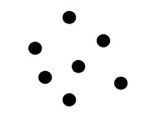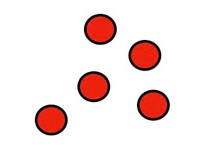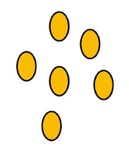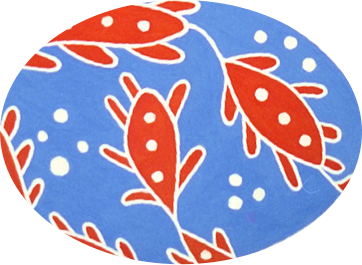Dots and Spots
Крапочки і цятки

Dots and Spots
Крапочки і цятки
Dots or spots on an egg are a very simple and thus fairly common motif. They can be simple, pinpoint dots, like these

An example is the Volynian pysanka at the top of this page, from Binyashevsky. These simple dots are said to have many meanings. Often they appear to be decorative elements, used as a way of enhancing or emphasizing other motifs, as in these examples from Podillia and Pidliashia:


Scattered or clustered spots can be said to represent either the stars in the sky, or cuckoo birds’ eggs, the latter being a symbol of spring. This pysanka on the left from Vinnytsia has many dots, probably representing stars; the one on the right, from the Poltava region, intersperses larger dots (stars) with crossed circles (moons):


As in the Poltavan pysanka above, dots can also be larger, (usually) colored in circles or ovals:


Dots of this sort were often placed on a pysanky along with rain and agricultural motifs, and are generally understood to symbolize seeds. Examples of simple seed motifs can be seen in this pysanka from the Chernihiv region:

The pysanka on the left below is from the Hrubeshiv area (now in Poland, formerly the Kholm region). The seeds (dots) are surrounded by waved lines (a water motif). The one n the right is from Binyashevsky, form the village of Yavoriv in the Kosiv region (Hutsul); we see curls, which are water symbols (Zmiya), in conjunction with seeds/dots


These pysanky, from the Vinnytsia region, show dots and circles in conjunction with “rakes”; the rakes, of course, are actually clouds, with the tines representing rain.


Dots/seeds can also be seen in conjunction with plants. In the pysanky below from the Talne region of Cherkasy oblast (Central Podniprovia), are two such examples. In one we see leaves and seeds; in another the seeds are shown in a flower head.


These three pysanky from Binayshevsky (Hutusl from Yavoriv, Bili Oslove and Nyzhniy Bereziv, respectively) also have plants associated with dots:



Spots can also be large, irregularly shaped “splotches” like the one below.

They were created by dripping or smearing wax onto a pysanka, and were probably placed on the eggshell to add more color to a pysanka with a dark background without a lot more work. They are seen most often in Hutsul pysanky, but appear in those of other regions as well. The Hutsuls called them “slezy” (tears), and they are most often red smears on a dark background.
Why slezy/tears? It may simply reflect the smear shapes, or it may have to do with a legend that is told by some of the time the Virgin Mary gave eggs to the soldiers guarding the cross. As she did so, she entreated them to be less cruel to her son, and she wept. Her tears fell upon the eggs, spotting them with dots of brilliant color, creating the first pysanky.
These are two such examples of such Hutsul pysanky; the one on the right with horses is from the town of Zhabie, now known as Verkhovyna.


These pysanky reflect the modern Hutsul color scheme; in earlier times, the final color would have been a deep brown (walnut), as natural dyes would have been used, and the reds would have been more orange.
These two pysanky are from Bukovyna, from the village of Berehomet, depicting “Beans” and a “Snail.” In the former, you can see that beans/seeds can be teardrop shaped as well as round or oval.


These large splotches can be found on pysanky from Podillia, too; the pysanky below with vazon motifs are from Yankiv (Vinnytsia region) and Nemyrivshchyna, respectively.



Not all splotches are red, though; these examples from Binyashevsky are both from Pokuttia and have multicolored splotches. The pysanka on the left if from Pereryv, Kolomyia raion; the one on the right is from the village of Beleyiv(?):


And these two examples come from the Kyiv and Lviv regions; the latter is a pysanka originally recreated by Olena Kulchytska.


These last two examples, also from Binyashevsky, also have multicolored splotches; they are from Zalishchyky in Podillia and the Kherson region:


Seeds, stars, tears and eggs........
